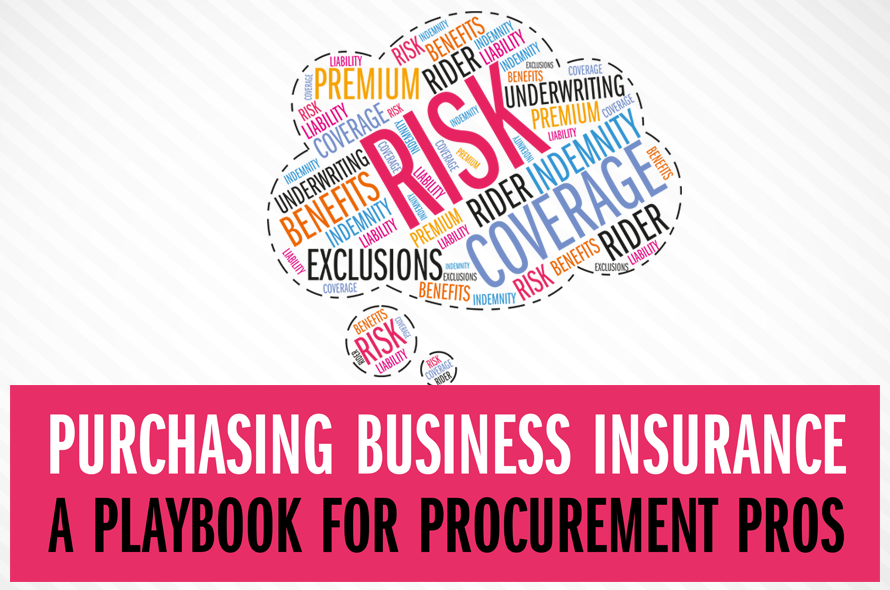Introduction
In the face of mounting risk and rising premiums, business insurance is fast climbing up the cost savings agenda of large global enterprises. Organizations are increasingly looking toward procurement to optimize their insurance costs and drive more value from their spend.
Purchasing business insurance has traditionally been a “specialist” domain. Involving procurement in the purchase of business insurance can be quite a challenge due to the rather complex workings of the market, the difficulties of identifying and covering risks, and the general aversion of risk managers to accept procurement support.
Nevertheless, procurement can add a lot of value and minimize the total cost of risk by bringing greater transparency and accountability to the insurance purchasing process.
This paper includes strategies, practical tips and advice for procurement professionals to develop a strong insurance program that offers adequate risk coverage for the business while optimizing costs.
The purchase of business insurance has traditionally been under the ambit of the insurance or risk director within the organisation. Often, this is a sole individual with a wide scope of responsibilities covering:
- Identification and disclosure of company assets and risks to be insured
- Selection of a broker partner with whom to work
- Determination of strategy and structure of the business insurance program
- Agreement to participating insurers and premium spend
Purchasing decisions are often steered by the appointed broker in a particular direction and there is a reliance on the broker's relationship with the market to obtain the best quotes and access markets inaccessible to the enterprise directly. It is therefore essential that the enterprise has independent insight into the insurance procurement process, predominantly to assure key stakeholders that correct purchasing decisions have been taken through a transparent and open process, based on the risk profile of the business.
The involvement of procurement professionals in purchasing business insurance can introduce a greater level of transparency and accountability to the process, adding structure, corporate governance controls and protocol to a practice that's historically been based on trust and relationships. However, this is not the only benefit brought by their involvement; procurement professionals can assist in negotiating terms, particularly for fee-driven services. This can place a distance between the day-to-day operations of the program and corporate negotiations, ensuring best value for money is obtained without impacting operational relationships.
Effective procurement of business insurance requires a combination of ingenuity in approach, market awareness, technical knowledge, experience and relationships — it's closer to being an art than a science. However, a healthy relationship between the risk director and procurement team will help develop a business insurance program that can be justified, provides adequate protection and is aligned to the enterprise's financial capacity.
 Procurement's Value Add
Procurement's Value Add
From a procurement perspective, the aim is to ensure that the insurance purchases made are appropriate, are being purchased effectively and at the right price. However, this area cannot be considered in isolation and is not limited to the purchase of insurance but the whole risk approach taken by the enterprise. Risk management here encompasses three key areas:
- Loss control – ensuring the appropriate precautions are in place
- Loss financing – ensuring funds are available in the event of loss
- Risk reduction – diversification away from risk or withdrawal
Purchasing insurance protection is simply one solution to loss financing and the overall risk management environment. Procurement professionals must take a holistic view when making any recommendations related to purchasing business insurance. Involvement of procurement in purchase of business insurance can be quite a challenge due to the rather complex workings of the market, the intricacies of establishing risk and, not least, the general aversion of risk managers to embrace procurement support. Nevertheless, there are some key areas where procurement can add value to the purchase decisions made. The inclusion of procurement in the decision-making process can bring greater transparency and accountability to a somewhat murky area.
 Getting the Buy-In
Getting the Buy-In
The biggest challenge procurement professionals may encounter is to engage constructively with key purchasers who might be reluctant to embrace the challenge that procurement can bring to the process and may not welcome external insight into this “specialist” domain.
Some enterprises may seek to entirely outsource their risk management and insurance responsibilities and will be happy to engage a broker partner to provide extensive support at a cost. Any external provider will be naturally reluctant to engage with procurement professionals that may challenge their own position. Some businesses have a well-established, in-house risk management/insurance team in place and it might take some time to build a relationship and open up the team to the benefits of procurement's involvement.
Any procurement professional attempting to engage in the insurance sector must, therefore, have a strong understanding of the market dynamics, the organisation's history and key factors essential in determining insurance purchase decisions. The starting point for this is simply to listen carefully to the incumbent purchaser's description of program structures, challenges, decisionmaking processes adopted and rational for the approach currently taken. It is necessary to understand the approach adopted to date and then validate this with other corporate stakeholders and board members to measure the degree of cohesion. Often, the risk appetite of a corporate board is actually higher than the risk approach adopted by the current purchaser, which opens up ample opportunities for procurement to negotiate.
The sophistication of program structures can vary enormously, dependent on the evolutionary stage the enterprise has reached in its own life cycle. A young, rapidly expanding business involved in new technologies may have a heavy reliance on broker recommendations, purchasing conventional insurance cover at a low level for a relatively high price. There's scope here for procurement to introduce sound strategies and methodologies to the process — resulting in a more challenging purchasing environment — and bring cost savings to the table.
Large global corporations usually establish the use of captive insurances to retain business risk and develop a strong understanding of their own risk profile and appetite. However, even in such cases, opportunities exist to extend or restructure retained risk, challenge services and fees, and capitalize on market opportunities. Developed risk programs can often become stagnant and out of sync with the enterprise's current direction and financial capabilities.
 Understanding Total Cost of Risk (TCOR)
Understanding Total Cost of Risk (TCOR)
Once integrated into the process, or as a one-off review, there are some key areas that procurement should review to challenge or validate existing arrangements.
Almost always, the first starting point for a procurement review should be to establish the TCOR of the enterprise. This should include:
- Premium cost of all policies (both global and local)
- Retained cost of claims in any captive program or self-insured excesses
- Broker and captive management fees (including any local broker fees) and any funding costs associated with letters of credit or any other alternative funding costs
- Cost of risk reduction activities
Data collection and validation can be undertaken by back office procurement staff providing administrative support to insurance purchasers that they may not have within their own resources.
In the first instance, if the focus is on global insurance purchases then the element of local cost may be excluded. However, for a longer-term overview, it is essential to capture these costs on a central database. The TCOR must be established to provide a baseline measurement against which any savings can be properly evaluated. Savings may look easily achievable by adjusting policy limits or accepting larger deductibles, however, it is no good to simply reduce one area of spend [premium] to then potentially increase costs elsewhere [claims]. The TCOR should take all costs or potential costs into consideration.
 Delivering the Benefits
Delivering the Benefits
A key challenge for a procurement-driven review is to deliver financial benefits within the established timetable of the procurement process, which will often be in conflict with the renewal cycle of key insurance policies. Any procurement-led review will need to be cognizant of the natural annual renewal cycle of the business insurance program. Key structural changes will need to be identified, costed and agreed — in time with the renewal cycle — so that implementation can take place at the natural renewal date of policies. Enforced changes mid-term will undoubtedly expose enterprises to increased risk, weaken established relationships between the insured and their insurers, and reduce potential benefits.
Program structure is one area where procurement can deliver the greatest impact by challenging convention and thinking outside the box. Once the corporate risk profile has been established, discussions can take place with the purchasers to determine the risk appetite of the corporation and how this sits with the established program.
Procurement professionals can provide an objective view of the current program and constructively challenge the current supply arrangements, especially the ones that are based on long-standing relationships and have become the “norm.” This is not something that can occur on an annual basis and benefits gained can quickly erode again if structural changes are not allowed to establish themselves. However, a substantive five-year review practice should be a part of the corporation's risk management strategy.
Risk Retention
The level of self-insured retention assumed by the enterprise is often more cautious compared with the sustainable level of loss the business can weather. Effective insurance purchasing is all about getting the right balance between retention and protection and preventing any nasty surprises. Losses are acceptable if the possibility that they may occur is understood by stakeholders and if the appropriate economic evaluation occurs. However, unexpected — losses that occur when the enterprise has no idea about the risks it was exposed to — must be regarded as unacceptable. Accordingly, risk management solutions, consistent with the enterprise's appetite and philosophy, must focus on the trade-off between cost and benefit.
A key element to retaining risk is ensuring that operational areas of the business are aware of the philosophy behind the approach and act appropriately in their delivery. An effective internal risk management program is an essential element to any program and increasing retentions within the corporate structure can aid development and adherence to risk management practices within the operation.
Communication and direction to operating subsidiaries is essential. One of the greatest failures of a global insurance strategy based on increased self-insured retentions is the tendency of local operating subsidiaries to purchase “in-fill” cover from their local market to protect their own financial performance. This spend can often be hidden and lost to the global “TCOR” calculation. Nevertheless, it undermines the performance of the corporate strategy and reduces the focus on good risk management.
Captive Optimization
Retained risk is predominately managed through the utilization of a captive insurance company and optimization of the captive involvement is essential in establishing the correct risk strategy of the enterprise. There are costs involved in running a captive and these should be factored into any cost evaluation exercise.
In the initial stages of establishing a captive program, caution should be exercised, allowing time for the captive to establish itself and build reserves while managing its exposure to loss. However, once established, the presence of a captive allows an enterprise to take bolder steps with retention levels, knowing that it has sufficient funding in hand in the event of a major loss. The blending of risks into a captive enables premium income to be combined to fund potential losses. This has a benefit over transferring the risk to the market where conventional silos still exist and the blended benefits cannot be assumed at this bottom end.
Breadth and Scope of Cover
One of the most obvious but longer-term area for review is the range of policies purchased and the limits of those policies. Policy coverage can often overlap and that means the insured's paying twice for the same cover. It is essential to understand the scope of each policy and remove any elements of cover that may — or can — be protected elsewhere. Equally, it is important to ensure that all risks are adequately covered and a procurement review may actually identify the need to purchase more insurance but which, in turn, reduces the risk exposure of the business. These two aspects are often referred to as “gaps and laps”. This is where procurement can take a more long-term approach to the category, working with the insurance team to understand coverage in more detail to ensure policies meet and respond to the risks of the business in question, without being too broad in nature.
How much cover to buy is always a difficult question; luckily most corporations have not had to face their 'worst-case loss scenario' and, therefore, the calculation of 'estimated maximum loss' values is based on hypotheses and speculation. The tendency of an enterprise will be to be persuaded to increase liability policy limits when the market is soft and premiums are cheap. However, there may not be a proper evaluation of risk undertaken to establish the need for such limits.
Nevertheless, when the market hardens and premiums increase, it is a brave risk manager that recommends liability limits should be reduced. The board will rightly challenge why it is now prudent to buy less cover if the risks to the business are unchanged? This can be a high-risk/low-gain area, given that premium savings at the top end of an insurance program will be minimal in cost per million terms.
An enterprise should certainly avoid being swayed by the vagaries of the insurance market cycle, while not being oblivious to opportunities that may exist during soft market cycles. The enterprise should ensure that its insurance purchasing decisions are based on proper evaluation of its risk appetite.
One way to save on premium without increasing risk is to manipulate “layering” to achieve an improved overall spend; a conventional insurance “tower” will see decreasing “cost per million” rates the higher it goes. Stretching higher layers downwards, therefore, sees the benefit of the reduced rate being brought to a lower level. Similarly, combining or splitting layers can bring savings – the decisions as to what combination achieves the best outcome can only be evaluated through each renewal period as quotations are gathered.
Fees and Costs
While not a major area of spend, broker’s fees can add up to a significant sum. All major broking firms will seek to maximize their income by encouraging insureds to utilize the wide range of services they offer beyond the mere purchase of insurance. These may include risk management services, captive management, claim management, global representation, alternative risk transfer schemes and a plethora of further services. An unwary enterprise can easily become embroiled in an ever-growing provision of services and overreliance on its broker to manage risks. It is essential to establish precisely what the broker is doing for the firm and how much is being paid for those services.
Most business insurance purchases have now moved away from payment by traditional brokerage income and are now remunerated by a fixed fee. However, there can still be some brokerage rebates earned, especially in less developed territories. These must be understood and declared to the enterprise. A broker will not necessarily do this voluntarily and, therefore, questions must be asked by procurement.
Insurers
The natural tendency of insurers is to operate in individual silos working by policy type with specialty departments providing either property, liability, excess casualty or reinsurance, and so on. An enterprise, with a broad range of global placements, may find that the same insurer participates in many different areas of the program but there is little attention and benefit given for accumulation of business to one insurer. One of the benefits of compiling a TCOR database (if this does not already exist) is being able to get a full overview of insurer participation. A review of insurer aggregation provides an ideal opportunity for procurement to adequately leverage the accumulated risk with one insurer.
Local vs. Global
Traditionally, key business insurances are purchased by the parent company to provide protection to their subsidiaries and shareholders. A board has obligations to ensure that risks are adequately covered and this governs most insurance decisions. On the other hand, many of a parent's subsidiary operations may want to simply protect their own risks and financial performance.
A careful balance needs to be struck here between maintaining business protection and buying appropriate local policies. Usually, a combination of both is the outcome with certain risks being left to local operations to source cover (a typical example being motor insurance) and key liability and perhaps property polices being provided centrally. Local policies will generally exists for employeerelated risks but this is more to do with differing local legislation and provision than a specific corporate policy. What is important is that the corporation lays down clear guidelines as to what is to be covered centrally and what remains the responsibility of local operations.
For a full picture to emerge, the costs of any locally procured insurance should be known to the center. Procurement can play a key role in establishing this data and assist in developing geographical or global program if sufficient gains can be evidenced through eradication of local purchasing options.
Direct Contracts
Convention dictates that insurance is purchased through an intermediary (the broker). While this doctrine still holds true for most purchases, there is a growing shift toward direct placement for certain coverages, which can bring benefits to savvy purchasers. In areas such as property and auto insurance, and — more recently — employee benefit risks, corporate purchasers can negotiate terms directly with a band of insurers willing to trade on this basis. Procurement assistance and expertise can prove essential here, taking the process element of the work away from the insurance professionals and introducing sourcing protocols to this sector.
Procurement expertise may also look to challenge the conventional purchasing methods in the traditional marketplace and proponents can look for opportunities to bring in competitive tendering and market auctions. However, there is, undoubtedly, still a lot of reluctance to such practices within the insurance sector. Again, it is the less volatile insurance purchases (propertybased risks) that may benefit from such an approach, besides procurement of broker services.
Conclusion
As can be seen from the aforementioned considerations, simply saving premium is not necessarily the best outcome for an enterprise. Perhaps, this is why procurement is eyed by insurance professionals as an adversary. It is necessary to take a holistic view of the total cost of risk before changing limits, coverage, or even key insurers. However, there are opportunities out there to find better value for money by being inventive, challenging convention and persuading insureds to take a different view of risks or coverage offered.
All of these opportunities are things that should be ongoing within an enterprise in any event. However, the involvement of procurement can bring greater insight and validate these existing processes or challenge why they don't exist, if that's the case. The decision-making process of an insurance purchase is often undocumented and hence unauditable – procurement governance can bring greater transparency and accountability to these purchase decisions.

